As the site is updated, each listing includes the shipping cost. Some listings which I have not updated still give you calculated shipping costs based on weight and size of package. (In the sections I have updated) If you select several different listings, we will consolidate your order and charge you the actual cost of the entire package. The shipping over charge will be refunded to you, when your order is shipped.
OYSTER SHELLS FROM AROUND THE WORLD INCLUDE HIGHLY POLISHED TO THE PACIFIC THORNY OYSTER AT DISCOUNT PRICING
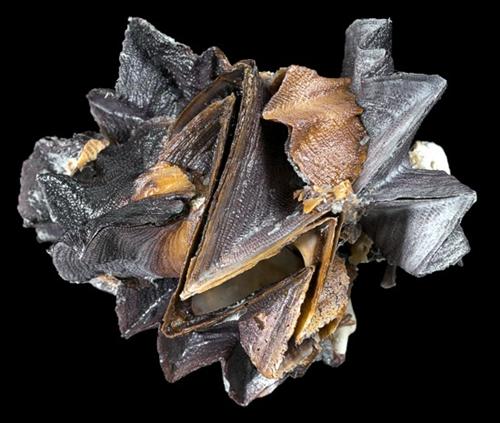
Zigzag Oyster
Lopha cristagalli commonly called the ZigZag oyster or the cockscomb oyster, is a species of marine bivalve molluscs in the family Ostreidae.
The cockscomb oyster's shell can reach up to 8 inches in diameter, though it is typically around 4 inches. Its color varies from dark to light purple, featuring a thick, strongly ribbed, and slightly inequivalve structure. The interior of the shell is porcelain-like, often appearing purplish-brown or whitish. The valve margins display a distinctive zig-zag pattern, while the surfaces of both valves are dotted with numerous small, low, rounded bumps. These mollusks are sedentary epifaunal suspension feeders, filtering sea water to extract nutrients.
Juvenile oysters attach themselves to solid surfaces on the seabed. Many possess spines that serve as a defense mechanism against predators—animals that hunt and consume other animals for sustenance. The zigzag oyster, known as a true oyster, is edible and characterized by its robust, thick shell with sharp ridges.
This species is widespread in the Indo-West Pacific, from East Africa, including Madagascar, Mauritius, the Red Sea, Seychelles, and the Persian Gulf, to Micronesia; north to Japan and south to Papua New Guinea and Indonesia. It lives on coral reefs in shallow subtidal waters at depths of 16 to 98 feet.
Scientific classification
Domain: Eukaryota
Kingdom: AnimaliaPhylum: Mollusca
Class: BivalviaOrder: Ostreida
Family: Ostreidae
Genus: Lopha
Species: L. cristagalli
(Linnaeus, 1758)(REF: ) Melvill, J. C. (1898). Further investigations into the molluscan fauna of the Arabian Sea, Persian Gulf, and the Gulf of Oman, with the descriptions of forty species. Memoirs and proceedings of the Manchester Literary & Philosophical Society. 42(4))(REF: Sheppard, A (1984). The molluscan fauna of Chagos (Indian Ocean) and an analysis ot its broad distribution patterns. Coral Reefs 3 )
H1-5
A Zigzag Oyster that measuring 4 and 5 inches........$9.10
H2-5
One Zigzag Oyster, measuring at least 5 inches........$13.49
H3-5
One Zigzag Oyster measuring 9 inches......OUT OF STOCK
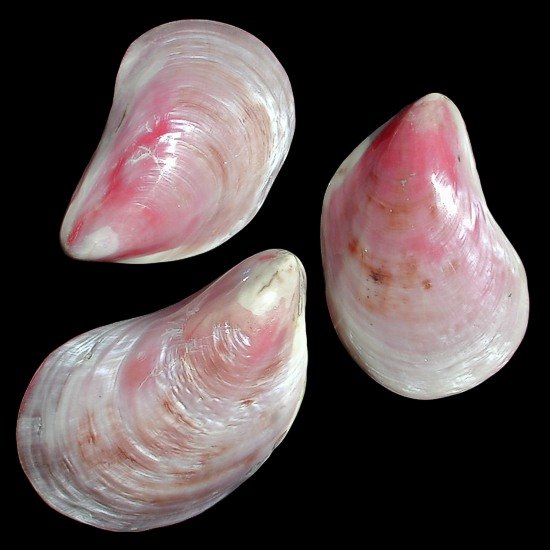
THE SELOY OYSTER SHELL
Seloy's are from the western Pacific
These are smooth bodied bivalve They popular with collectors. The picture of the Seloy shows too much pink. Ninety nine percent of the Seloy's are various shades of purple and rarely pink. Even so, the shells are very colorful. AA0-11 A whole Seloy Oyster, measuring at least 4 inches......$3.25 SPONDYLUS VARIUS OYSTER Spondylus varius, a species of large marine bivalve mollusk in the Spondylidae family, is commonly known as the Spiny Oyster. It is the largest among the spiny oysters, with a maximum size of approximately 8 inches. The adult shell of Spondylus varius is easily identifiable by its white color, although it can also be crimson or yellowish.
These mollusks dwell at depths of up to 99 feet and are filter feeders, depending on plankton for nourishment. Spondylus varius is found throughout the Indo-Pacific region, inhabiting the waters off Australia, China, the Philippines, Japan, and Taiwan. Scientific classification
Domain: Eukaryota Kingdom: Animalia Phylum: Mollusca Class: Bivalve Order: Pectinida Family: Spondylidae Genus: Spondylus Species: S. varius (REF: Sowerby, G. B. I. (1827). Catalogue of the whole of that splendid collection of rare shells, madrepores, carved paddles and other curiosities formed by Mr. Samuel Stutchbury, … and brought home by the Pacific Pearl Company's Ship, the Sir George Osborne. Which will be sold by auction by Mr. Sowerby … on Thursday, July 26th, 1827. London. 10 pp.; Appendix. Observations on a few of the most remarkable shells collected by Mr. Samuel Stutchbury on the coast of some of the islands of the Australasian and Polynesian groups, together with descriptions of a few new species. London. 4 pp)(REF: Huber, M. (2010). Compendium of bivalves. A full-color guide to 3,300 of the world's marine bivalves. A status on Bivalvia after 250 years of research. Hackenheim: ConchBooks. 901 pp) SPONDYLUS REGIUS OYSTER Spondylus regius, known as the regal thorny oyster, belongs to the bivalve mollusks in the Spondylidae family. This species inhabits the Western Pacific and can reach a size of up to 7 inches. The regal thorny oyster is located in the Red Sea, around the Philippines, in Japanese waters, and in the Coral Sea, dwelling on coral rubble at depths ranging from 17 to 263 feet. Scientific classification Domain: Eukaryota Kingdom: Animalia Phylum: Mollusca Class: Bivalvia Order: Pectinida Family: Spondylidae Genus: Spondylus Species: S. regius (REF: "Spondylus regius, regal thorny oyster". www.sealifebase.org. Retrieved 2019)(REF:"Family: SPONDYLIDAE - Bagni Liggia" (PDF). www.bagniliggia.it. Retrieved 2021)(REF:"Encyclopedia of Life". www.eol.org. Retrieved 2021) G1-3 One whole Spondylus Regius Oyster, measuring 3 to 4 inches.......$18.25 G2-3 A Spondylus Regius Oyster, measuring 4 to 5 inches.....
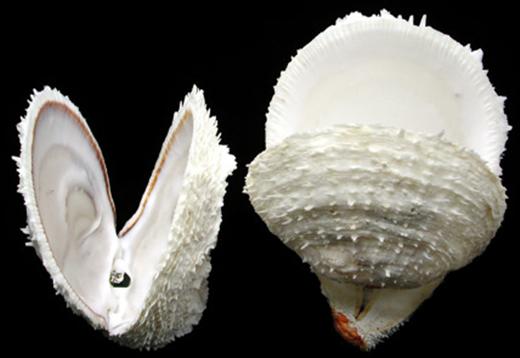
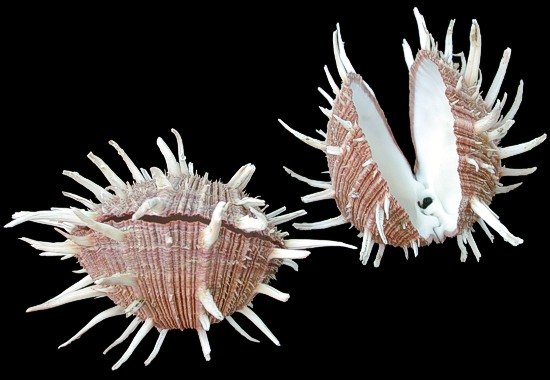
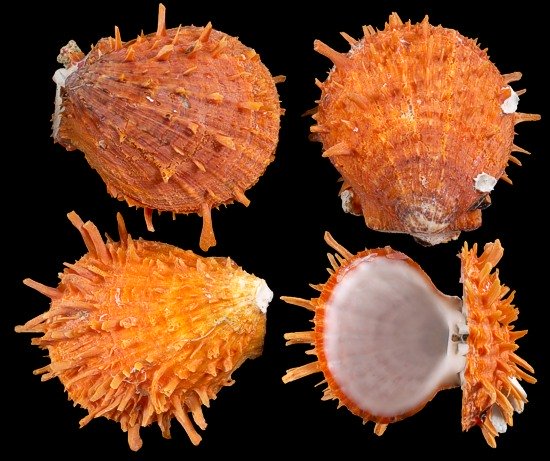
SPONDYLUS DUCALLIS OYSTER
The Spondylus Ducallis Oyster is another of the 40 some spiny oysters. This Oyster is found in the Indo-Pacific region. All are tropical water dwellers and they like the other spiny oysters attach themselves to hard objects.
Q1-5
One complete Spondylus Ducallis Oyster measuring 3 to 4 inches ......OUT OF STOCK
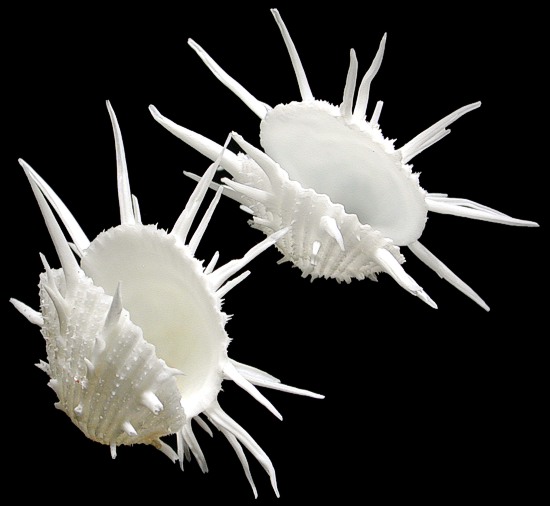
SPONDYLUS IMPERIALIS OYSTER
The Spondylus Imperialis Oyster is another spiny oyster found in the Indo-Pacific region. As with other oysters, it attaches itself to a hard surface.
This oyster can grow up to 6 inches, the most common length is about 3 inches.
The Spondylus Imperialis have been found across the Indo-West Pacific: from India and Sri Lanka to the Philippines; north to Japan and south to Indonesia.PS2-17
One complete Spondylus Imperalis Oyster measuring 3 to 4 inches......$8.49
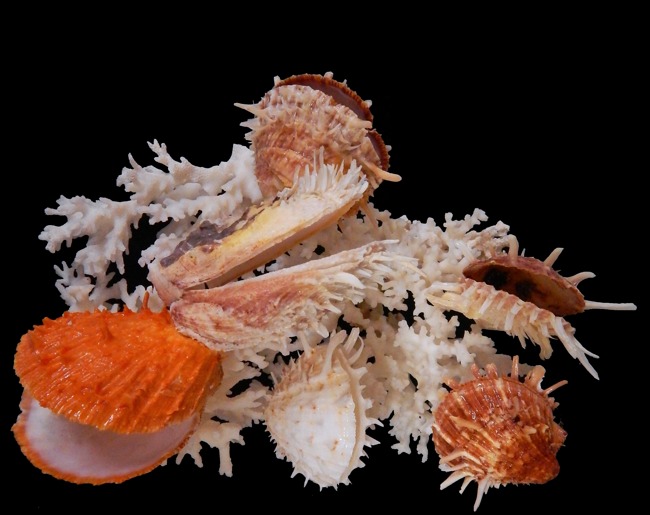
SPINY OYSTER PAIRS ASSORTED SPECIES
They are found across the Indo-Pacific region.
Spiny Oysters have been found in tropical seas as shallow as 1 foot to as deep as 150 feet.
01-5
One 3 to 4 inch Spiny Oyster Pair sold in assorted types of spiny oysters...... .75
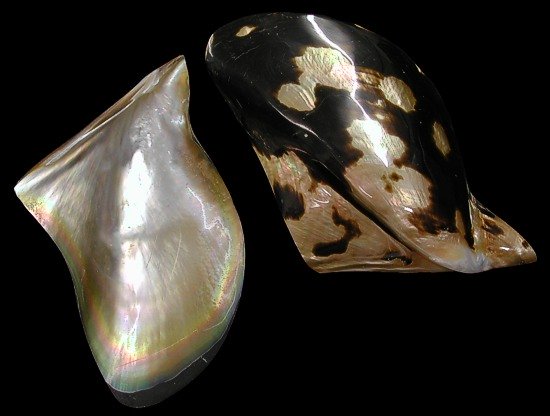
PTERIA PENGUIN Common Name BROWNLIP OYSTER
the penguin's wing oyster, is a species of marine bivalve mollusk in the family Pteriidae, the pearl oysters. It is native to the western and central Indo-Pacific region and is used for the production of cultured pearls. The generic name comes from Greek πτερον (pteron) meaning wing.
It is found attached by its byssal threads to a number of different substrates, rocks and corals (especially to Gorgonacea), at intertidal depths less 1156 feet.
Pteria penguin can reach a common shell length of about 8 inches, with a maximum length of 12 inches). The shells of this rather large species are solid and ovate. The posterior ear develops a narrow, elongated, wing-like expansion. The left valve is more inflated than the right one. The outside color of the shell ranges from dark brown to black, while the interior is nacreous silvery, a wide non-nacreous glossy black margin
Scientific classification
Domain: Eukaryota
Kingdom: AnimaliaPhylum: Mollusca
Class: Bivalvia
Order: Pteriida
Family: Pteriidae
Genus: Pteria
Species: P. penguin
P0-15
One complete Polished Brown Lip Oyster measuring 3 to 4 inches ....... $1.75
P1-15
One Brown Lip Oyster measuring at least 5 inches........ $4.95
P2-15
One Brown Lip Oyster shell measuring 6 to 8 inches........ $6.35
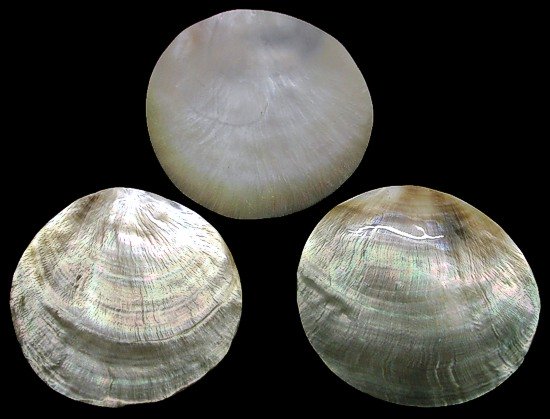
Pinctada margaritifera common name BLACKLIP OYSTER
This is a species of pearl oyster, a saltwater mollusk, a marine bivalve mollusk in the family Pteriidae. They are common in the Indo-Pacific within tropical coral reefs.
The ability of P. margaritifera to produce pearls means that the species is a valuable resource to humans. The oysters are harvested wild from coral reefs and are also commonly grown in aquaculture, in the Indo-Pacific region.
The common name of this species refers to the black coloring along the margins of the interior of the shell. Externally the shell is dark grayish brown or green, though white spots are common across the shell. Adults usually reach between 8 to 10 inches in height. A distinctive feature of the species is that the hinge has no teeth.
Pinctada margaritifera occupies a wide range throughout the Persian Gulf, Red Sea, Sudan, Papua New Guinea, Australia, French Polynesia, Cook Islands, Indonesia, Andaman and Nicobar Islands, Southwestern part of the Indian Ocean, Japan and the Pacific Ocean, and various locations on the coast of India.
The pearl oyster attaches itself to barnacles and other hard substrates via a byssus. They thrive at intertidal and subtidal zones, at depths from the low tide to up to 27 feet. Habitats are usually characterized as oligotrophic and having low turbidity. Other species, including sponges, hydroids, polychaetes, lamellibranchs, amphipods, decapods, echinoderms, and fishes, usually have close relationships with pearl oyster beds.
This species is commonly farmed and harvested for pearls, and there is general consensus that the quality of pearls from Pinctada margaritifera is the highest quality out of all the pearl oysters. Pearls form when a parasite or other irritant enters into the oyster and nacre is released by the oyster to coat the object, eventually creating a small pearl. It is a popular myth that sand is a common irritant that induces pearl nucleation, however, this is very rarely, if ever, the case. Bivalves are able to flush sand from their bodies extremely effectively, and studies of pearl nuclei have shown that the overwhelming majority form from parasitic incursion, other organic irritants, or even tissue damage. The oyster's release of the nacre serves as an adaptation of the immune system to isolate the invasive particle and irritation. P. margaritifera in particular produces gray or black pearls.
Scientific classification
Domain: Eukaryota
Kingdom: Animalia
Phylum: Mollusca
Class: Bivalvia
Order: Pteriida
Family: Pteriidae
Genus: Pinctada
Species: P. margaritifera
I1-15
One polished bivalve Black Lip Oyster Shell measuring 1 to 1 1/2 inches...... .65
I2-15
One polished bivalve Black Lip Oyster Shell measuring 1 1/2 to 2 inches...... .75
I3-15
One polished bivalve Black Lip Oyster Shell measuring 2 to 2 1/2 inches...... $1.15
I4-15
One polished bivalve Black Lip Oyster Shell measuring 2 1/2 to 3 inches...... $1.75
I5-15
One Bivalve Black Lip Oyster Shell measuring 3 to 4 inches ...... $3.39
I6-15
One polished bivalve Black Lip Oyster Shell measuring 4 to 4 1/2 inches.....$7.75
I7-15
One bivalve polished Black Lip Oyster shell measuring 4 1/2 to 5 inches......$9.15
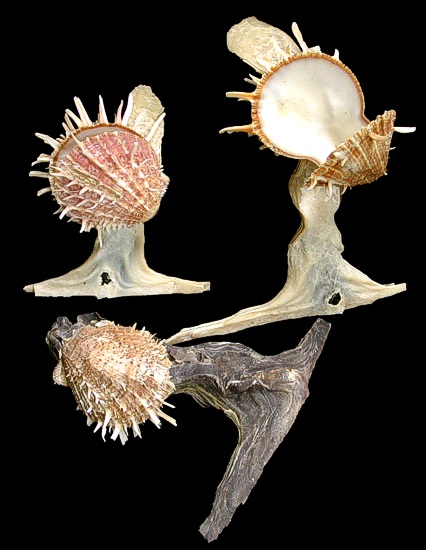
Hammer Head Oyster with Spiny Oyster
Malleidae, or hammer oyster, is a family of saltwater clams. They are related to the pearl oysters, in the order Pteriida[1] and the superfamily Pterioidea.
The shells of most of these animals are T-shaped, with the hinge along the top of the T, and with the byssus emerging from the hinge. An oblique ligament holds the hinge. The shell is partially nacreous. There is a single, large adductor muscle. The exhalant current exits at the hinge.
Most hammer oysters live in tropical, coralline areas.
Scientific classification
Domain: Eukaryota
Kingdom: Animalia
Phylum: Mollusca
Class: Bivalvia
Order: Pteriida
Super family: Pterioidea
Family: Malleidae
E1-5
One Hammer Head Oyster Shell with an attached Spiny Oyster measuring 6 to 7 inches ..... $2.10
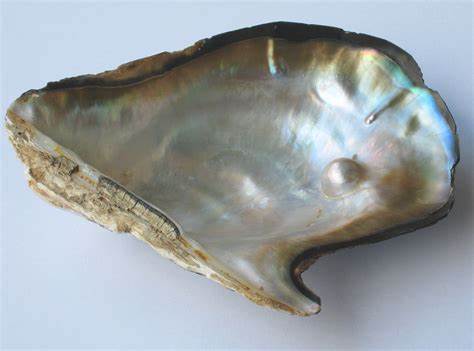
NATURAL PEARL OYSTER SHELL This is a Natural Pearl Oyster shell that has a Ruff back and a natural pearl finish inside.
XX2-15
One Natural Pearl Oyster Shell measuring 3 to 5 inches.... $1.10
XX1-15
One Natural Pearl Oyster measuring 5 to 6 inches $2.10
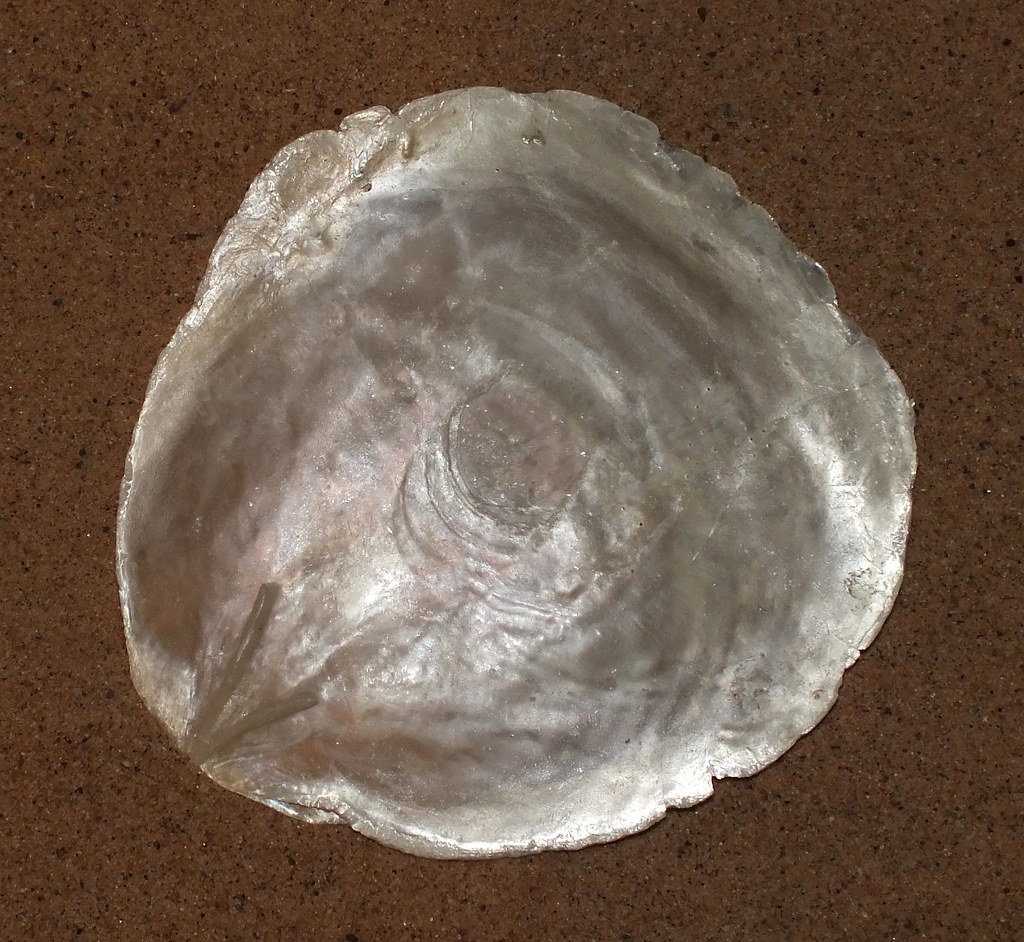
Placuna also known as windowpane oysters
Placunidae, also known as windowpane oysters, windowpane shells, and Capiz shells, are a taxonomic family of saltwater clams, marine bivalve mollusks which are related to oysters and scallops.
This family is best known for the shells of the species Placuna placenta, which are translucent, and are commonly used in shellcraft production. In some cultures, they are cut into 2" x 2" and pressed by a 1/4" wood and are used as a form of light-admitting window. This shells are a bit reflective and are even used as room movable divider (partition).
This family is closely related to the Anomiidae (saddle oysters). One of the main differences is that the Placunidae do not attach themselves to a hard surface but are instead a mud-living family.
The windowpane oysters are valued for their translucent shell. The shells were originally used as a glass substitute in glazing, but nowadays they are mainly used in the manufacture of trays, lampshades and numerous decorative items.
In coastal areas the flesh is eaten.
Domain: Eukaryota
Kingdom: Animalia
Phylum: Mollusca
Class: Bivalvia
Order: Pectinida
Family: Placunidae
Rafinesque, 1815
Genus: Placuna
Lightfoot, 1786
(REF:Bieler R, Bouchet P, Gofas S, Marshall B, Rosenberg G, La Perna R, Neubauer TA, Sartori AF, Schneider S, Vos C, ter Poorten JJ, Taylor J, Dijkstra H, Finn J, Bank R, Neubert E, Moretzsohn F, Faber M, Houart R, Picton B, Garcia-Alvarez O (eds.). "Placuna Lightfoot, 1786". MolluscaBase. World Register of Marine Species )(REF: "Fisheries and aquaculture of window-pane shells". Malacological Society of London. Retrieved on 2011-10-23. )(REF:Poutiers, J. M. (1998). "Bivalves (Acephala, Lamellibranchia, Pelecypoda)". In Carpenter, K. E.; Niem, V. H. (eds.). The living marine resources of the Western Central Pacific Volume 1. Seaweeds, corals, bivalves and gastropods. FAO Species Identification Guide for Fishery Purposes. Vol. 1. Rome: FAO. p. 216. ISBN 92-5-104052-4. )
A2-15
A Placuna Oyster measuring 4 to 6 inches.... .69